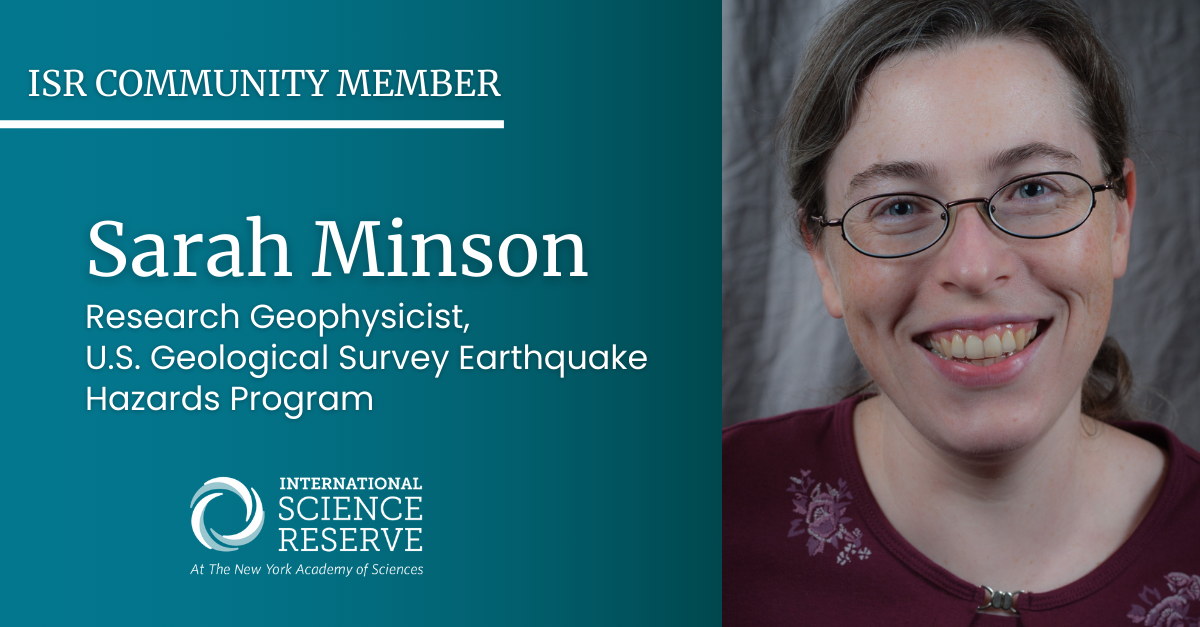“Did you feel it?” How understanding small earthquakes readies us for big ones
by ISR Staff

Sarah Minson is a Research Geophysicist with the U.S. Geological Survey Earthquake Hazards Program. Sarah’s research attempts to understand not only how faults slip, but also to understand what we can and cannot determine about earthquake ruptures and how these uncertainties affect our estimates of potential earthquake impacts. She has also studied earthquake early warning systems to determine what kinds of warning are possible, and what kind of accuracy can be achieved.
Sarah recently joined an ISR webinar about earthquake preparedness, and then spoke to our team about how we can apply lessons from earthquakes across crisis preparedness efforts.
In early 2024, earthquakes struck Japan, Taiwan, and the United States. How did they fare in terms of being prepared for disaster?
Japan, Taiwan, and the United States all have high building standards and strong earthquake preparedness programs, which can help mitigate infrastructure damage and reduce casualties, but these are still traumatic events. Our hearts go out to everyone who was impacted by these earthquakes.
The Japan and Taiwan earthquakes were much larger magnitude events, causing strong shaking and significant damage. Both Japan and Taiwan have earthquake early warning systems, although the performance of the systems differed significantly. Because these earthquakes were located along the coast, causing seafloor deformation, they both led to tsunamis. There were tsunami warnings and evacuations immediately following each earthquake. In both events, landslides and rockfalls triggered by the earthquake shaking produced significant damage. These earthquakes were devastating, and their impacts will be felt for a while, but the high degree of preparedness in both Japan and Taiwan, as well as their earthquake and tsunami warning systems, helped to mitigate the impacts.
The United States is also highly prepared with earthquake and tsunami warning systems. The New Jersey earthquake was a smaller magnitude event that was onshore. Therefore, it could not trigger a tsunami, so these systems did not come into play. The most significant impact of the New Jersey earthquake was probably how many people felt the shaking.
One thing of note about the central and eastern United States is that shaking amplitudes decay very slowly with distance from the earthquake compared to the western United States. This is, in part, because there are so few earthquake faults. The rock is strong and intact. Thus, a huge region — and a huge number of people — can feel shaking from even a relatively small magnitude earthquake like this one.
After any earthquake, we encourage people to visit our website for earthquake information and to report whether they did (or did not) feel shaking. These observations are very valuable and help us understand how shaking from earthquakes varies. We received a record almost 184,000 “Did You Feel It?” reports for the New Jersey earthquake. It is the largest number of responses to “Did You Feel It?” for a single event since the program began in 1999 and broke the previous record of 140,000 responses for the 2011 M5.8 Mineral, Virginia earthquake (another eastern U.S. earthquake).

Can you share more about your research into early warning systems?
The first thing to know about earthquake early warning is that the name is terrible. It is not an earthquake warning. Instead, we monitor earthquakes as their ruptures evolve and warn people (and trigger automated protection systems) before the shaking from the earthquake arrives at their location.
The most familiar measure of an earthquake is magnitude, which is a single and simple number that literally describes the physical size of an earthquake rupture. Magnitude is the length of the earthquake rupture, multiplied by the width of the rupture, multiplied by how far one side of the fault slid relative to the other side. Then the result is converted to a logarithmic scale.
However, the shaking from an earthquake is highly variable and will not be the same for everyone. Shaking intensity decreases with distance from the earthquake, but can be amplified or deamplified by the type of soil you are standing on (hard rock or soft soil), your relationship to the dynamic evolution of the earthquake (whether it is rupturing towards you or away from you), and your personal situation (for example, whether you are on the ground floor or top floor of a building).
The single thing that most affects earthquake early warning accuracy is our ability to forecast what the shaking will be at your location. But even if our shaking models were perfect, there would still be accuracy and time limitations because earthquakes are not instantaneous: their ruptures evolve over seconds (for small magnitude earthquakes) to minutes (for large magnitude earthquakes).
If we were to wait for an earthquake to conclude so that we can make our best possible shaking forecast, we would use up all the warning time before the shaking arrived at your location. So, earthquake early warning must always be to some extent precautionary: we are alerting you to an earthquake in progress that has the potential to continue evolving into something that could cause significant shaking at your location.
During the ISR’s recent webinar on earthquakes, you spoke about scientists working with structural engineers and building designers to design buildings with earthquake science in mind. Why is cross-sector collaboration important in a crisis?
The U.S. Geological Survey’s mission is to serve the Nation by providing reliable scientific information to describe and understand the Earth. One of our most important products is a national seismic hazard model that forecasts the intensity and frequency of earthquake shaking everywhere in the country. This is the information that can determine to what strength of shaking infrastructure must be resilient. That is, what level of shaking must a building be able to withstand for it to be safe. But how safe is safe? How unlikely and infrequent an earthquake is sufficiently unlikely and infrequent when it comes to earthquake risk?
These questions must be answered by people and their representatives in conversation with structural engineers and designers, balancing not just earthquake hazard considerations but all sorts of other hazards and societal needs and risks. What earthquake scientists can and do provide is scientific analysis so that people can make informed decisions.
You also spoke about planning ahead and prioritizing the safety of people with disabilities during disasters. Can you share your best practices?
In the webinar, Yuichi Ono, director of the International Research Institute of Disaster Science at Tohoku University, gave a very informative overview of some of the difficulties that were encountered in the aftermath of the January 1, 2024, M7.5 Noto Peninsula, Japan earthquake, and the special risks faced by those who are older or disabled. In the United States, where earthquakes are relatively infrequent and we may not have personal memory of a damaging earthquake, we can look to our recent experiences with other sorts of natural disasters, such as wildfires and hurricanes, to see how evacuations and recovery can be more or less difficult based on people’s individual circumstances and physical abilities.
One thing that is unusual about earthquakes relative to many other natural disasters is that they do not require evacuation, although tsunamis resulting from earthquakes can require immediate evacuation. Instead, in the United States where buildings are built to a life safety standard and should not collapse during an earthquake, the protective action that everyone should take when they feel earthquake shaking (or receive an alert from an earthquake early warning system that shaking is imminent) is drop, cover, and hold on to protect themselves from falling or being struck by something.
This protective action can be adapted to everyone’s individual mobility. The U.S. Geological Survey through the National Earthquake Hazards Reduction Program (NEHRP) as well as governmental and non-governmental science, preparedness, and emergency response organizations are all working to make earthquake preparedness accessible to all.

What steps should you take if you feel an earthquake or get an early warning?
There are three things I personally would like everyone to know about earthquakes. One is how to protect yourself. As we just discussed, if you ever feel shaking or get a warning: drop, cover, and hold on to protect yourself.
The second thing is that earthquakes are not magic. Earthquakes obey simple laws of physics: a point on a fault is stressed, it moves, it transfers stress to the surrounding parts of the faults; if those parts of the faults are sufficiently stressed, they move too; and the more parts of the fault that move the larger the earthquake.
The problem is that we get to observe none of this. These faults are moving miles underground where we have no direct observations of the stress on the fault or the material of the fault interface or whether it is lubricated by fluids or glued together by small-scale fault structures. All we can do is observe how the surface of the Earth deforms in response to what is happening at depth and attempt to infer what is happening on the fault. This is what limits our ability to tell you what is happening on the fault right now, or what will happen in the future. This is why we cannot predict earthquakes. It is not because we do not understand earthquake physics (we do) and it is not because earthquakes are magic (they are not magic).
Lastly, I personally would like everyone to know that the largest source of earthquake hazard is not “The Big One” – an infrequent large magnitude earthquake. The bigger hazard is the medium ones. While each of these more moderate magnitude earthquakes impact a smaller area (again, magnitude literally comes from the length of an earthquake rupture) and usually have less intense shaking, they sometimes produce strong shaking, and they happen much more frequently than large magnitude earthquakes.
Why does this matter? When people focus on The Big One like a M8 earthquake that happens only every few hundred years, they may feel fatalistic: why prepare for something that is so rare and so scary? But if instead you focus on the more common earthquakes that happen year in and year out, the kinds of earthquake that you might even have lived experience with, the kind of earthquake that you are actually most likely to have to deal with, then you can be confident about being prepared for an earthquake.
Visit https://www.ready.gov/earthquakes for easy preparedness steps you can take. If you feel shaking, drop, cover and hold on. Have a plan for your family. Put your grandma’s dishes somewhere safe so that they do not fall off a shelf in the shaking from a moderate magnitude earthquake. These things are doable. These things can keep you and your family (and grandma’s dishes) safe.


